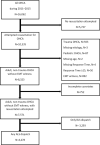Influence of advanced life support response time on out-of-hospital cardiac arrest patient outcomes in Taipei
- PMID: 35421162
- PMCID: PMC9009650
- DOI: 10.1371/journal.pone.0266969
Influence of advanced life support response time on out-of-hospital cardiac arrest patient outcomes in Taipei
Abstract
Background: The association between out-of-hospital cardiac arrest patient survival and advanced life support response time remained controversial. We aimed to test the hypothesis that for adult, non-traumatic, out-of-hospital cardiac arrest patients, a shorter advanced life support response time is associated with a better chance of survival. We analyzed Utstein-based registry data on adult, non-traumatic, out-of-hospital cardiac arrest patients in Taipei from 2011 to 2015.
Methods: Patients without complete data, witnessed by emergency medical technicians, or with response times of ≥ 15 minutes, were excluded. We used logistic regression with an exposure of advanced life support response time. Primary and secondary outcomes were survival to hospital discharge and favorable neurological outcomes (cerebral performance category ≤ 2), respectively. Subgroup analyses were based on presenting rhythms of out-of-hospital cardiac arrest, bystander cardiopulmonary resuscitation, and witness status.
Results: A total of 4,278 cases were included in the final analysis. The median advanced life support response time was 9 minutes. For every minute delayed in advanced life support response time, the chance of survival to hospital discharge would reduce by 7% and chance of favorable neurological outcome by 9%. Subgroup analysis showed that a longer advanced life support response time was negatively associated with the chance of survival to hospital discharge among out-of-hospital cardiac arrest patients with shockable rhythm and pulse electrical activity groups.
Conclusions: In non-traumatic, adult, out-of-hospital cardiac arrest patients in Taipei, a longer advanced life support response time was associated with declining odds of survival to hospital discharge and favorable neurologic outcomes, especially in patients presenting with shockable rhythm and pulse electrical activity.
Conflict of interest statement
The authors have declared that no competing interests exist.
Figures



References
-
- Ono Y, Hayakawa M, Iijima H, Maekawa K, Kodate A, Sadamoto Y, et al.. The response time threshold for predicting favourable neurological outcomes in patients with bystander-witnessed out-of-hospital cardiac arrest. Resuscitation. 2016;107:65–70. doi: 10.1016/j.resuscitation.2016.08.005 - DOI - PubMed
Publication types
MeSH terms
LinkOut - more resources
Full Text Sources
Medical

